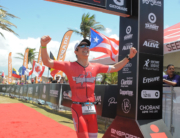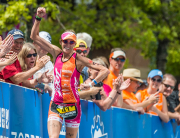
When people start the ‘contemplation’ phase of doing a triathlon, more often that not, the swim is the most daunting. Unless you grew up around the water or were exposed to swimming early in life, it can be intimidating and more challenging to master. Or if you grew up in Australia. If you grew up in Australia, you should just jump right in. I’m always amazed at how incredible the Aussies are in open water; and the choppier the better. So yes – either a) you grew up swimming or b) you were exposed when young or c) you’re Australian, in which case you have gills and you can thank your parents for having raised you part fish.
But for those of us who grew up land locked, it will take some work. But much like anything in life, the only way to know if you CAN do something is to TRY. I’ve seen people go from struggling through 1000 yards (in +/-45 minutes) to three months later finishing a ½ Ironman in open water and going on to complete the race. While I’m sure they wouldn’t claim this to have been ‘easy’, it takes a few simple steps: Find a pool that is accessible and convenient. If it isn’t convenient to your schedule and routine, chances are the swim workouts will be the first to go when life gets busy. Put more time into your swim relative to the other disciplines. If you’re aiming to do your first triathlon, perhaps your week looks like 2 bike rides, 2-3 runs, and 3-4 swims. The point is, to get stronger you need to spend time in the water. Finally, take the time to ensure good technique. This means having someone who knows swimming (and how to teach swimming) watch you and give you feedback early on. You will be amazed at how a few simple adjustments to your stroke can impact your efficiency and ultimately speed.
Now that we have the basics down (you’ve hit the pool, you’re doing regular swims, and you feel fairly comfortable in the water), what can you do to ensure you will get the most out of your sessions? I have learned (having swum since age 4) I take for granted the simple things that we ‘as swimmers’ know; pace clocks, how workouts are laid out, what ‘sets’ are. To toe a triathlon feeling confident about your swim, try to think like a swimmer (with an open water focus). Here are a few tips.
1) Use the pace clock & know your pool. In the old days, the pace clock was the large round thing on the wall with a rotating arm. It’s simple and it doesn’t lie, like our fancy and sneaky GPS devices do. When you hit the pool, hopefully you can spot a pace clock in some capacity; if not this, it may be digital. Use it. Do not use your GPS watch. A pool is measured and consistent. It will likely be 25 yards, 25 meters, or 50 meters long (some older pools are 33 yards in length). Ask what it is and know the distance. From here, you’re set. After you warm up, do a simple set such as 6x50s. Start on the “top” or the 60 (or the start of a minute), push off, swim your 50 and look at the clock. Do the math. If you come in on the 47, you just did a 50 in 47 seconds. Eventually you will work towards knowing your “Per 100 pace” (i.e: this was a 1:34 pace), and now, you’re in business. You can do workouts and start to gauge where you are starting from and visibly see your progress in the pool (we hope!).
2) Use the toys; but not as a crutch. As you become more comfortable and proficient, especially as a triathlete, the ‘toys’ have a place. The basics are a pull buoy, paddles, and fins. The buoy should stay between your thighs. Find what works for you; the one piece foam buoys slip on my legs, so I prefer the old fashioned $6 2-pieces of foam buoy attached with a strap. The stronger and more experienced swimmer you are, the larger paddles you can use. If you are beginner to intermediate, keep them about the size of your hand when you stretch out your fingers and not much larger. A great basic paddle is the Strokemaker brand, which has holes in it so you can feel the water (tip: remove the wrist strap and only use the finger straps, it will force you to have a better catch). As for fins, I advise the longer floppy fin as it will help increase ankle flexibility and will not “make it harder” for you as a short, more firm Zoomer type fin will (as a triathlete your legs are probably tired most the time in the water). HOW TO USE THE TOYS? A) Not all the time. Ideally warmup and do a main set sans toys (depending on the focus of the workout). B) Implement with a purpose. Pulling with a buoy only can help you work on the efficiency of your pull, and of course rests your legs a bit while propping up your body position. A buoy only also can limit your rotation. Pulling with paddles is an excellent way to improve upper body strength. If you hit the pool and find your body (especially legs) are shot, extra pulling is not a bad option. C) They can help with variety. Staring at a black line for 1 hr or more can get boring; while we need to grind through long and mundane sets at times, it is ok to toss on fins and do some kicking (on your back, arms overhead is good for your core) or do some very fast sprints (they will force your turnover to increase). They are not bad to have and use, just be sure you can swim strong and efficiently without them as well.
3) Hit the open water. It is different than a pool. It’s measurement is not precise; it is dark, it is deep; there are more waves, currents and at times swells. There are creatures (think of them as your friends). If at all possible, prior to your race (or if you have it available, use it regularly in your swim training), head to the open water and practice. Your stroke will adjust a bit. The choppier the conditions, the more you will increase your turnover. If the race is wetsuit legal, you will find you can propel significantly with very little kick; it is as if your legs have a built in buoy! Know what your race will likely entail and try to simulate it if you can prior. Not to mention, open water is fun! As we see miles clicked off and paces/power numbers in our face while cycling and running, it’s refreshing to get into a lake and just ‘go’. If this is not available to you, I advise doing some very long straight swims, working up to the distance of or close to what your event requires.
So there you have it. Swimming is fun. Embrace your inner fish. Now go, splash.

Photo by Mario Cantu

Amico the Dog (swimmer & Aussie dog)



